Health Economics: Analysis of US Healthcare Financing and Policy
VerifiedAdded on 2023/06/10
|10
|2523
|360
Report
AI Summary
This report provides a comprehensive analysis of health economics in the United States. It begins by emphasizing the importance of outcomes assessment and benchmarking as tools for performance measurement within healthcare organizations. The report then details various insurance methods, including fee-for-service, Preferred Provider Organizations (PPOs), Managed Care, and Health Maintenance Organizations (HMOs), discussing their implications. A significant portion is dedicated to examining the roles of Medicare and Medicaid, highlighting how they both enable and disable healthcare delivery in the US. The report further investigates the effects of the Affordable Care Act (ACA), exploring its impact on healthcare access and costs. Finally, it concludes with proposals for potential changes in the healthcare financing system in the United States, advocating for equitable distribution of funds based on state needs and offering policy recommendations. The report draws on various research sources to support its arguments and provide a well-rounded view of the subject.

Running head: HEALTH ECONOMICS
1
Health Care Economics
1
Health Care Economics
Paraphrase This Document
Need a fresh take? Get an instant paraphrase of this document with our AI Paraphraser
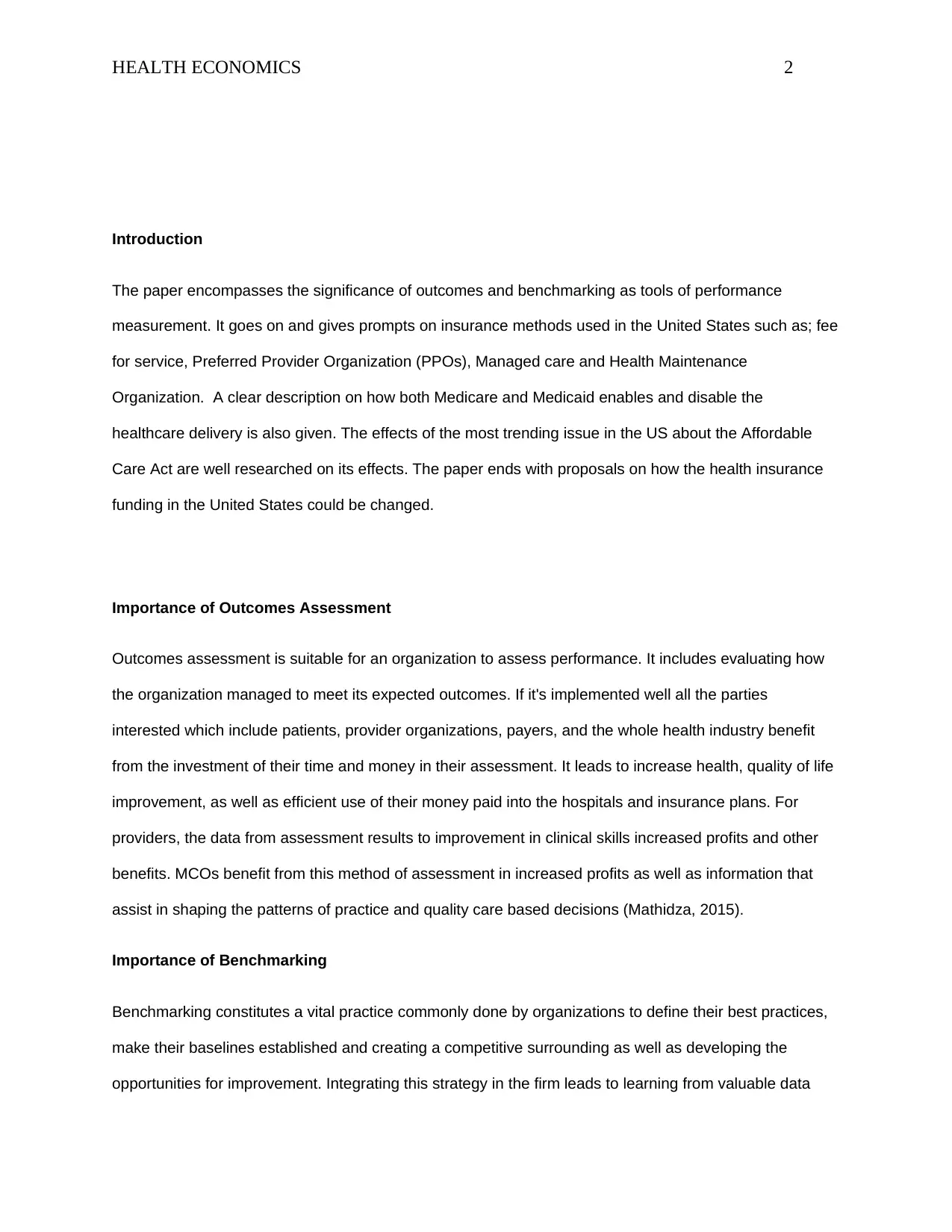
HEALTH ECONOMICS 2
Introduction
The paper encompasses the significance of outcomes and benchmarking as tools of performance
measurement. It goes on and gives prompts on insurance methods used in the United States such as; fee
for service, Preferred Provider Organization (PPOs), Managed care and Health Maintenance
Organization. A clear description on how both Medicare and Medicaid enables and disable the
healthcare delivery is also given. The effects of the most trending issue in the US about the Affordable
Care Act are well researched on its effects. The paper ends with proposals on how the health insurance
funding in the United States could be changed.
Importance of Outcomes Assessment
Outcomes assessment is suitable for an organization to assess performance. It includes evaluating how
the organization managed to meet its expected outcomes. If it's implemented well all the parties
interested which include patients, provider organizations, payers, and the whole health industry benefit
from the investment of their time and money in their assessment. It leads to increase health, quality of life
improvement, as well as efficient use of their money paid into the hospitals and insurance plans. For
providers, the data from assessment results to improvement in clinical skills increased profits and other
benefits. MCOs benefit from this method of assessment in increased profits as well as information that
assist in shaping the patterns of practice and quality care based decisions (Mathidza, 2015).
Importance of Benchmarking
Benchmarking constitutes a vital practice commonly done by organizations to define their best practices,
make their baselines established and creating a competitive surrounding as well as developing the
opportunities for improvement. Integrating this strategy in the firm leads to learning from valuable data
Introduction
The paper encompasses the significance of outcomes and benchmarking as tools of performance
measurement. It goes on and gives prompts on insurance methods used in the United States such as; fee
for service, Preferred Provider Organization (PPOs), Managed care and Health Maintenance
Organization. A clear description on how both Medicare and Medicaid enables and disable the
healthcare delivery is also given. The effects of the most trending issue in the US about the Affordable
Care Act are well researched on its effects. The paper ends with proposals on how the health insurance
funding in the United States could be changed.
Importance of Outcomes Assessment
Outcomes assessment is suitable for an organization to assess performance. It includes evaluating how
the organization managed to meet its expected outcomes. If it's implemented well all the parties
interested which include patients, provider organizations, payers, and the whole health industry benefit
from the investment of their time and money in their assessment. It leads to increase health, quality of life
improvement, as well as efficient use of their money paid into the hospitals and insurance plans. For
providers, the data from assessment results to improvement in clinical skills increased profits and other
benefits. MCOs benefit from this method of assessment in increased profits as well as information that
assist in shaping the patterns of practice and quality care based decisions (Mathidza, 2015).
Importance of Benchmarking
Benchmarking constitutes a vital practice commonly done by organizations to define their best practices,
make their baselines established and creating a competitive surrounding as well as developing the
opportunities for improvement. Integrating this strategy in the firm leads to learning from valuable data
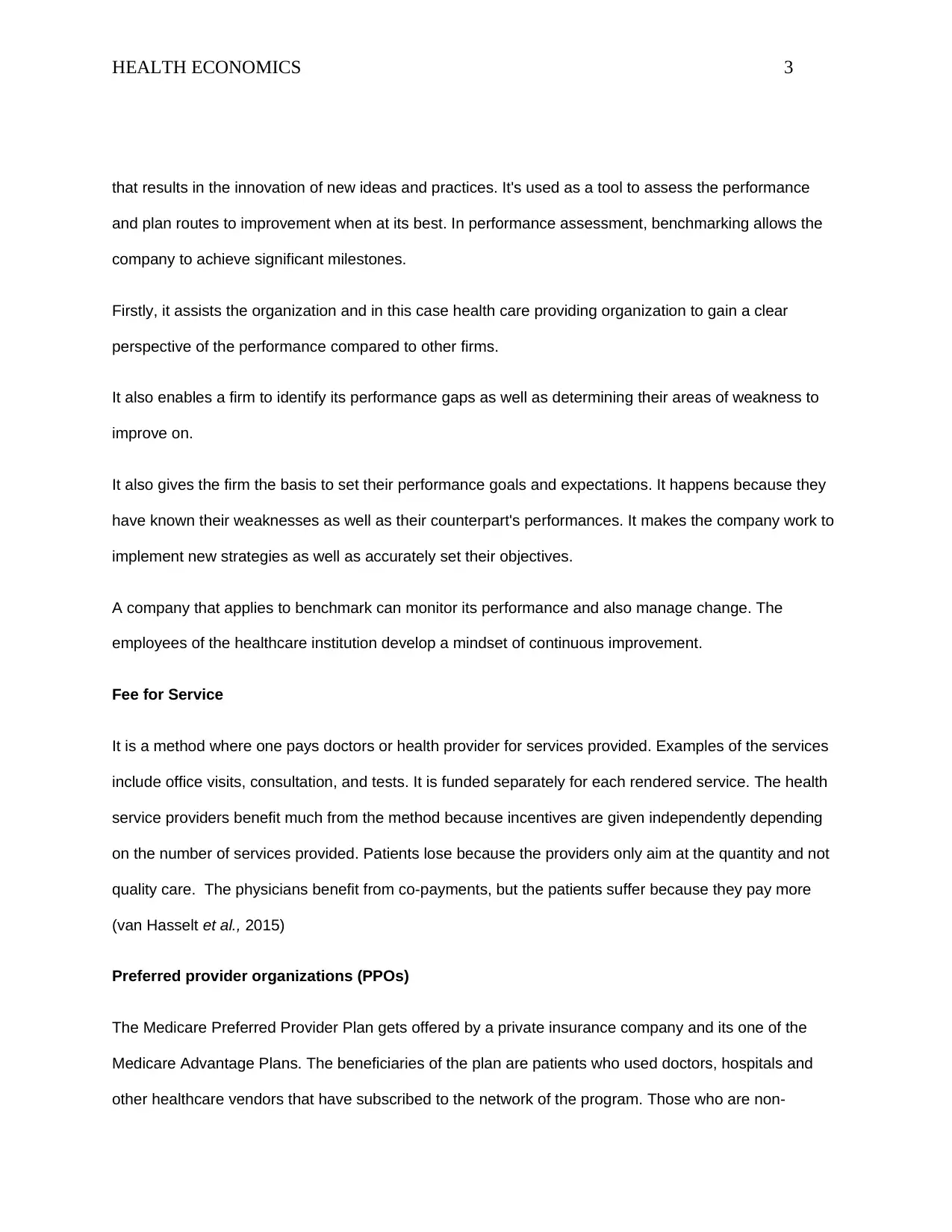
HEALTH ECONOMICS 3
that results in the innovation of new ideas and practices. It's used as a tool to assess the performance
and plan routes to improvement when at its best. In performance assessment, benchmarking allows the
company to achieve significant milestones.
Firstly, it assists the organization and in this case health care providing organization to gain a clear
perspective of the performance compared to other firms.
It also enables a firm to identify its performance gaps as well as determining their areas of weakness to
improve on.
It also gives the firm the basis to set their performance goals and expectations. It happens because they
have known their weaknesses as well as their counterpart's performances. It makes the company work to
implement new strategies as well as accurately set their objectives.
A company that applies to benchmark can monitor its performance and also manage change. The
employees of the healthcare institution develop a mindset of continuous improvement.
Fee for Service
It is a method where one pays doctors or health provider for services provided. Examples of the services
include office visits, consultation, and tests. It is funded separately for each rendered service. The health
service providers benefit much from the method because incentives are given independently depending
on the number of services provided. Patients lose because the providers only aim at the quantity and not
quality care. The physicians benefit from co-payments, but the patients suffer because they pay more
(van Hasselt et al., 2015)
Preferred provider organizations (PPOs)
The Medicare Preferred Provider Plan gets offered by a private insurance company and its one of the
Medicare Advantage Plans. The beneficiaries of the plan are patients who used doctors, hospitals and
other healthcare vendors that have subscribed to the network of the program. Those who are non-
that results in the innovation of new ideas and practices. It's used as a tool to assess the performance
and plan routes to improvement when at its best. In performance assessment, benchmarking allows the
company to achieve significant milestones.
Firstly, it assists the organization and in this case health care providing organization to gain a clear
perspective of the performance compared to other firms.
It also enables a firm to identify its performance gaps as well as determining their areas of weakness to
improve on.
It also gives the firm the basis to set their performance goals and expectations. It happens because they
have known their weaknesses as well as their counterpart's performances. It makes the company work to
implement new strategies as well as accurately set their objectives.
A company that applies to benchmark can monitor its performance and also manage change. The
employees of the healthcare institution develop a mindset of continuous improvement.
Fee for Service
It is a method where one pays doctors or health provider for services provided. Examples of the services
include office visits, consultation, and tests. It is funded separately for each rendered service. The health
service providers benefit much from the method because incentives are given independently depending
on the number of services provided. Patients lose because the providers only aim at the quantity and not
quality care. The physicians benefit from co-payments, but the patients suffer because they pay more
(van Hasselt et al., 2015)
Preferred provider organizations (PPOs)
The Medicare Preferred Provider Plan gets offered by a private insurance company and its one of the
Medicare Advantage Plans. The beneficiaries of the plan are patients who used doctors, hospitals and
other healthcare vendors that have subscribed to the network of the program. Those who are non-
⊘ This is a preview!⊘
Do you want full access?
Subscribe today to unlock all pages.

Trusted by 1+ million students worldwide
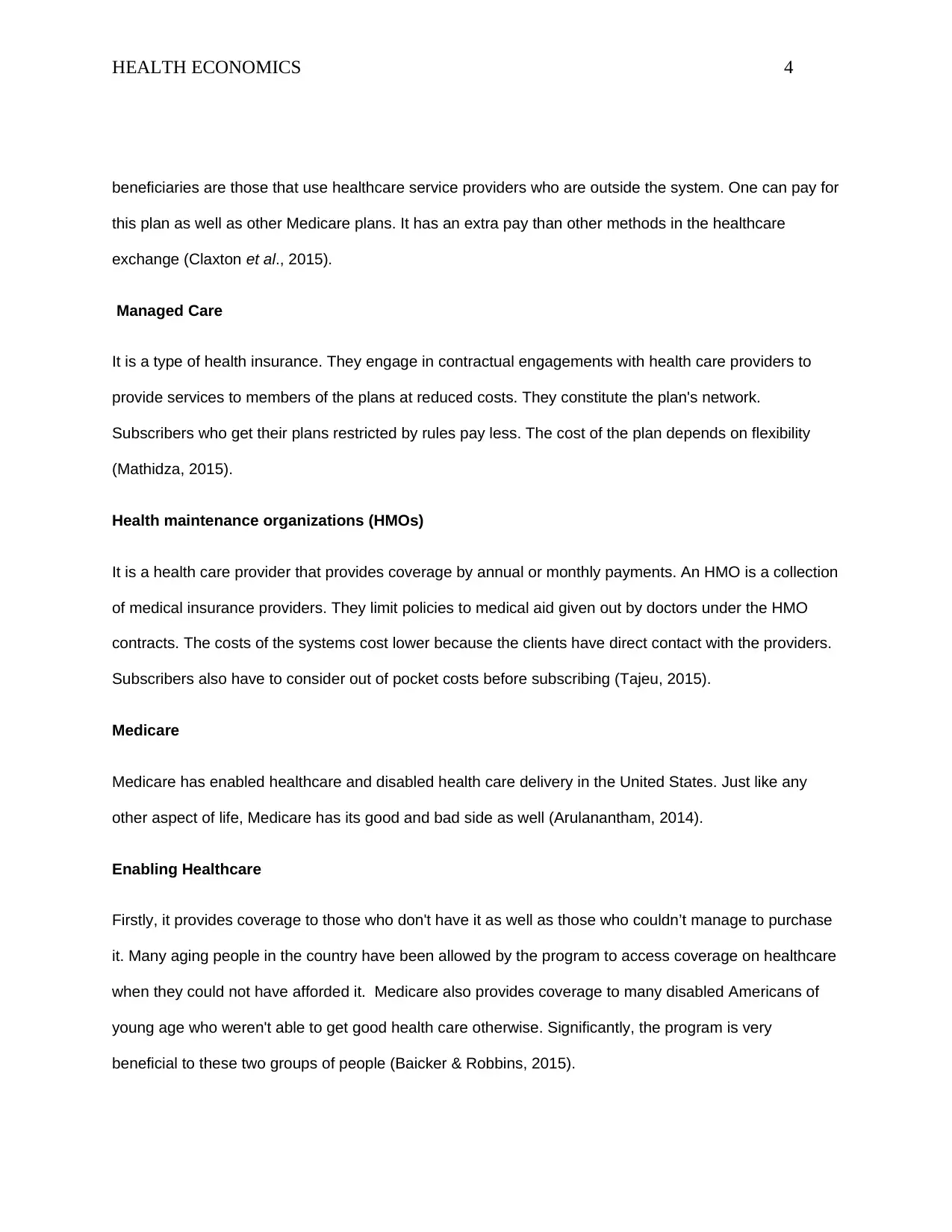
HEALTH ECONOMICS 4
beneficiaries are those that use healthcare service providers who are outside the system. One can pay for
this plan as well as other Medicare plans. It has an extra pay than other methods in the healthcare
exchange (Claxton et al., 2015).
Managed Care
It is a type of health insurance. They engage in contractual engagements with health care providers to
provide services to members of the plans at reduced costs. They constitute the plan's network.
Subscribers who get their plans restricted by rules pay less. The cost of the plan depends on flexibility
(Mathidza, 2015).
Health maintenance organizations (HMOs)
It is a health care provider that provides coverage by annual or monthly payments. An HMO is a collection
of medical insurance providers. They limit policies to medical aid given out by doctors under the HMO
contracts. The costs of the systems cost lower because the clients have direct contact with the providers.
Subscribers also have to consider out of pocket costs before subscribing (Tajeu, 2015).
Medicare
Medicare has enabled healthcare and disabled health care delivery in the United States. Just like any
other aspect of life, Medicare has its good and bad side as well (Arulanantham, 2014).
Enabling Healthcare
Firstly, it provides coverage to those who don't have it as well as those who couldn’t manage to purchase
it. Many aging people in the country have been allowed by the program to access coverage on healthcare
when they could not have afforded it. Medicare also provides coverage to many disabled Americans of
young age who weren't able to get good health care otherwise. Significantly, the program is very
beneficial to these two groups of people (Baicker & Robbins, 2015).
beneficiaries are those that use healthcare service providers who are outside the system. One can pay for
this plan as well as other Medicare plans. It has an extra pay than other methods in the healthcare
exchange (Claxton et al., 2015).
Managed Care
It is a type of health insurance. They engage in contractual engagements with health care providers to
provide services to members of the plans at reduced costs. They constitute the plan's network.
Subscribers who get their plans restricted by rules pay less. The cost of the plan depends on flexibility
(Mathidza, 2015).
Health maintenance organizations (HMOs)
It is a health care provider that provides coverage by annual or monthly payments. An HMO is a collection
of medical insurance providers. They limit policies to medical aid given out by doctors under the HMO
contracts. The costs of the systems cost lower because the clients have direct contact with the providers.
Subscribers also have to consider out of pocket costs before subscribing (Tajeu, 2015).
Medicare
Medicare has enabled healthcare and disabled health care delivery in the United States. Just like any
other aspect of life, Medicare has its good and bad side as well (Arulanantham, 2014).
Enabling Healthcare
Firstly, it provides coverage to those who don't have it as well as those who couldn’t manage to purchase
it. Many aging people in the country have been allowed by the program to access coverage on healthcare
when they could not have afforded it. Medicare also provides coverage to many disabled Americans of
young age who weren't able to get good health care otherwise. Significantly, the program is very
beneficial to these two groups of people (Baicker & Robbins, 2015).
Paraphrase This Document
Need a fresh take? Get an instant paraphrase of this document with our AI Paraphraser
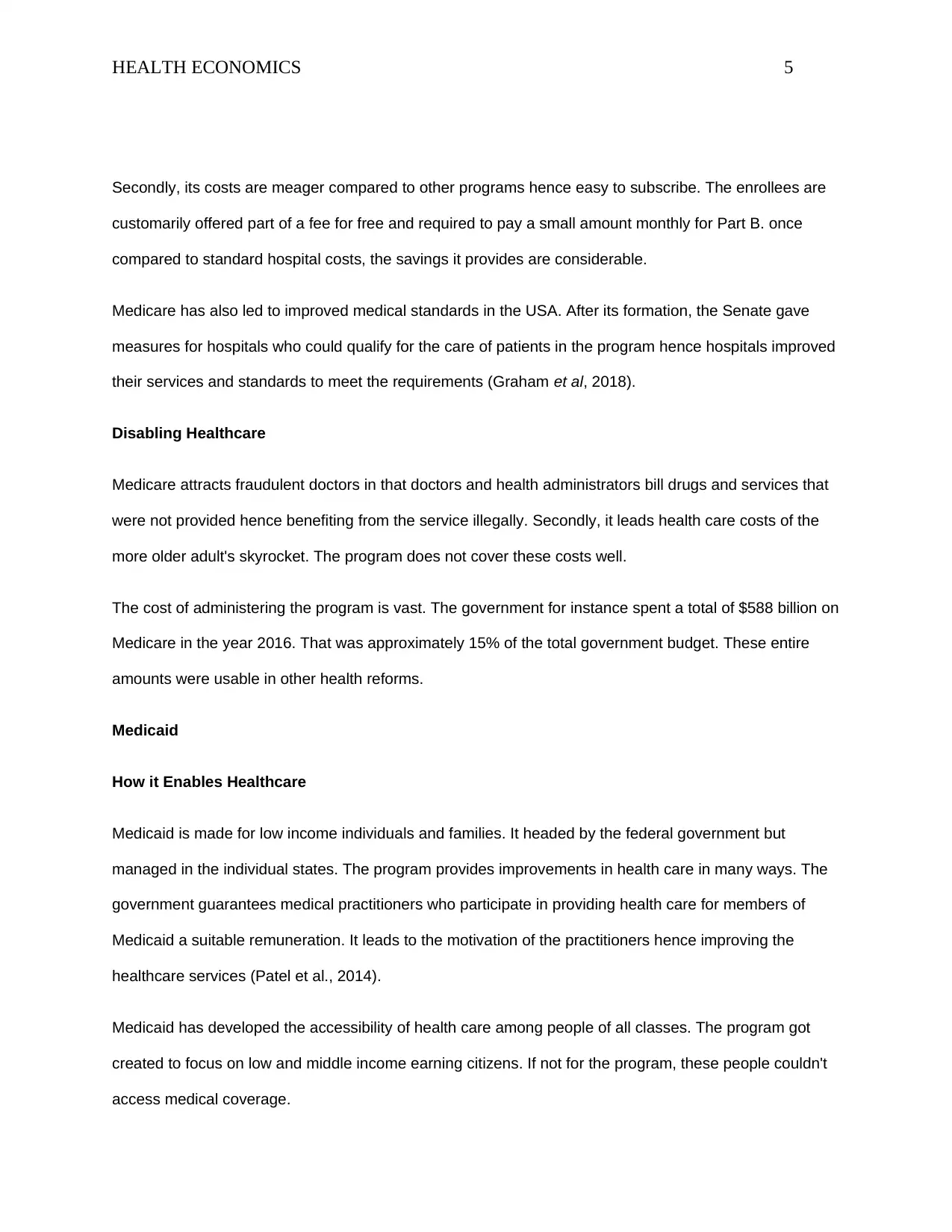
HEALTH ECONOMICS 5
Secondly, its costs are meager compared to other programs hence easy to subscribe. The enrollees are
customarily offered part of a fee for free and required to pay a small amount monthly for Part B. once
compared to standard hospital costs, the savings it provides are considerable.
Medicare has also led to improved medical standards in the USA. After its formation, the Senate gave
measures for hospitals who could qualify for the care of patients in the program hence hospitals improved
their services and standards to meet the requirements (Graham et al, 2018).
Disabling Healthcare
Medicare attracts fraudulent doctors in that doctors and health administrators bill drugs and services that
were not provided hence benefiting from the service illegally. Secondly, it leads health care costs of the
more older adult's skyrocket. The program does not cover these costs well.
The cost of administering the program is vast. The government for instance spent a total of $588 billion on
Medicare in the year 2016. That was approximately 15% of the total government budget. These entire
amounts were usable in other health reforms.
Medicaid
How it Enables Healthcare
Medicaid is made for low income individuals and families. It headed by the federal government but
managed in the individual states. The program provides improvements in health care in many ways. The
government guarantees medical practitioners who participate in providing health care for members of
Medicaid a suitable remuneration. It leads to the motivation of the practitioners hence improving the
healthcare services (Patel et al., 2014).
Medicaid has developed the accessibility of health care among people of all classes. The program got
created to focus on low and middle income earning citizens. If not for the program, these people couldn't
access medical coverage.
Secondly, its costs are meager compared to other programs hence easy to subscribe. The enrollees are
customarily offered part of a fee for free and required to pay a small amount monthly for Part B. once
compared to standard hospital costs, the savings it provides are considerable.
Medicare has also led to improved medical standards in the USA. After its formation, the Senate gave
measures for hospitals who could qualify for the care of patients in the program hence hospitals improved
their services and standards to meet the requirements (Graham et al, 2018).
Disabling Healthcare
Medicare attracts fraudulent doctors in that doctors and health administrators bill drugs and services that
were not provided hence benefiting from the service illegally. Secondly, it leads health care costs of the
more older adult's skyrocket. The program does not cover these costs well.
The cost of administering the program is vast. The government for instance spent a total of $588 billion on
Medicare in the year 2016. That was approximately 15% of the total government budget. These entire
amounts were usable in other health reforms.
Medicaid
How it Enables Healthcare
Medicaid is made for low income individuals and families. It headed by the federal government but
managed in the individual states. The program provides improvements in health care in many ways. The
government guarantees medical practitioners who participate in providing health care for members of
Medicaid a suitable remuneration. It leads to the motivation of the practitioners hence improving the
healthcare services (Patel et al., 2014).
Medicaid has developed the accessibility of health care among people of all classes. The program got
created to focus on low and middle income earning citizens. If not for the program, these people couldn't
access medical coverage.

HEALTH ECONOMICS 6
How it Disables Medical Care
It has undermined health standards in minor states in the US as the government allows wealthier
countries to be allocated more money than the poorer states which have much healthcare need resource
wise. The reimbursements of the program to doctors are very low as compared to what doctor's charge
usually. They discourage doctors and make hem neglect Medicaid patients (Levy et al, 2017). Small
medical practitioners avoid these patients because the reimbursements are released after 37-155 days
which is a lot of time. Patients are even neglected in private nursing homes by doctors citing that the
Medicaid quota has been reached (Hsu et al., 2018).
Effects of the Affordable Care Act
Americans nowadays purchase health insurance in the health exchanges. It led to the end of dependence
on employers cover or a group plan for health care insurance. It has reduced the cost of the healthcare
plan by ensuring each American benefits.
Many American citizens are averaging to 16 million, who lacked health insurance, got it due to the
introduction of the Affordable Care Act. It allows individuals who already have acute and critical conditions
to gain health care insurance and also youths can stay in their parent's insurance plans up to the age of
26 years. Considering the fluctuations of incomes of the employed citizens in the states, the ACA suits
them when they buy the Health Insurance plans via the exchange. In case the salary goes down, they will
have the chance to purchase plans of lower value, while if the salary increases they have the opportunity
to change their policy to those of higher quality (Frean &Gruber & Sommers, 2017).
The ACA provides the opportunities for the increase of competition thus enhancing quality and value
addition in the policies presented in the market. The ACA also provides for the establishment of consumer
protection policies hence making the business void of consumer exploitations.
According to all these beneficial provisions and advantages accruing from the ACA on the state health
insurance exchange, it's good to enact the requirements of the act in the states (Abney, 2014).
How it Disables Medical Care
It has undermined health standards in minor states in the US as the government allows wealthier
countries to be allocated more money than the poorer states which have much healthcare need resource
wise. The reimbursements of the program to doctors are very low as compared to what doctor's charge
usually. They discourage doctors and make hem neglect Medicaid patients (Levy et al, 2017). Small
medical practitioners avoid these patients because the reimbursements are released after 37-155 days
which is a lot of time. Patients are even neglected in private nursing homes by doctors citing that the
Medicaid quota has been reached (Hsu et al., 2018).
Effects of the Affordable Care Act
Americans nowadays purchase health insurance in the health exchanges. It led to the end of dependence
on employers cover or a group plan for health care insurance. It has reduced the cost of the healthcare
plan by ensuring each American benefits.
Many American citizens are averaging to 16 million, who lacked health insurance, got it due to the
introduction of the Affordable Care Act. It allows individuals who already have acute and critical conditions
to gain health care insurance and also youths can stay in their parent's insurance plans up to the age of
26 years. Considering the fluctuations of incomes of the employed citizens in the states, the ACA suits
them when they buy the Health Insurance plans via the exchange. In case the salary goes down, they will
have the chance to purchase plans of lower value, while if the salary increases they have the opportunity
to change their policy to those of higher quality (Frean &Gruber & Sommers, 2017).
The ACA provides the opportunities for the increase of competition thus enhancing quality and value
addition in the policies presented in the market. The ACA also provides for the establishment of consumer
protection policies hence making the business void of consumer exploitations.
According to all these beneficial provisions and advantages accruing from the ACA on the state health
insurance exchange, it's good to enact the requirements of the act in the states (Abney, 2014).
⊘ This is a preview!⊘
Do you want full access?
Subscribe today to unlock all pages.

Trusted by 1+ million students worldwide
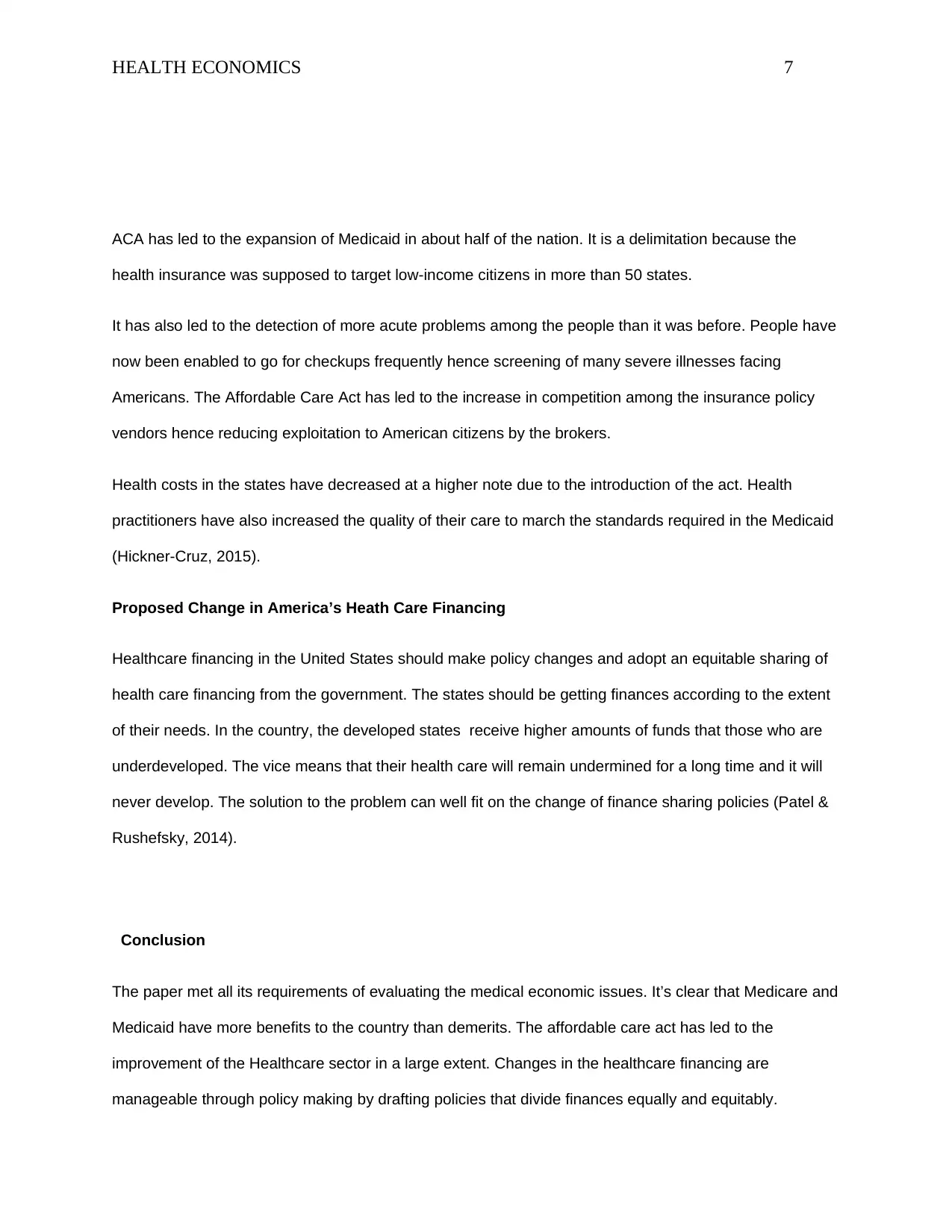
HEALTH ECONOMICS 7
ACA has led to the expansion of Medicaid in about half of the nation. It is a delimitation because the
health insurance was supposed to target low-income citizens in more than 50 states.
It has also led to the detection of more acute problems among the people than it was before. People have
now been enabled to go for checkups frequently hence screening of many severe illnesses facing
Americans. The Affordable Care Act has led to the increase in competition among the insurance policy
vendors hence reducing exploitation to American citizens by the brokers.
Health costs in the states have decreased at a higher note due to the introduction of the act. Health
practitioners have also increased the quality of their care to march the standards required in the Medicaid
(Hickner-Cruz, 2015).
Proposed Change in America’s Heath Care Financing
Healthcare financing in the United States should make policy changes and adopt an equitable sharing of
health care financing from the government. The states should be getting finances according to the extent
of their needs. In the country, the developed states receive higher amounts of funds that those who are
underdeveloped. The vice means that their health care will remain undermined for a long time and it will
never develop. The solution to the problem can well fit on the change of finance sharing policies (Patel &
Rushefsky, 2014).
Conclusion
The paper met all its requirements of evaluating the medical economic issues. It’s clear that Medicare and
Medicaid have more benefits to the country than demerits. The affordable care act has led to the
improvement of the Healthcare sector in a large extent. Changes in the healthcare financing are
manageable through policy making by drafting policies that divide finances equally and equitably.
ACA has led to the expansion of Medicaid in about half of the nation. It is a delimitation because the
health insurance was supposed to target low-income citizens in more than 50 states.
It has also led to the detection of more acute problems among the people than it was before. People have
now been enabled to go for checkups frequently hence screening of many severe illnesses facing
Americans. The Affordable Care Act has led to the increase in competition among the insurance policy
vendors hence reducing exploitation to American citizens by the brokers.
Health costs in the states have decreased at a higher note due to the introduction of the act. Health
practitioners have also increased the quality of their care to march the standards required in the Medicaid
(Hickner-Cruz, 2015).
Proposed Change in America’s Heath Care Financing
Healthcare financing in the United States should make policy changes and adopt an equitable sharing of
health care financing from the government. The states should be getting finances according to the extent
of their needs. In the country, the developed states receive higher amounts of funds that those who are
underdeveloped. The vice means that their health care will remain undermined for a long time and it will
never develop. The solution to the problem can well fit on the change of finance sharing policies (Patel &
Rushefsky, 2014).
Conclusion
The paper met all its requirements of evaluating the medical economic issues. It’s clear that Medicare and
Medicaid have more benefits to the country than demerits. The affordable care act has led to the
improvement of the Healthcare sector in a large extent. Changes in the healthcare financing are
manageable through policy making by drafting policies that divide finances equally and equitably.
Paraphrase This Document
Need a fresh take? Get an instant paraphrase of this document with our AI Paraphraser
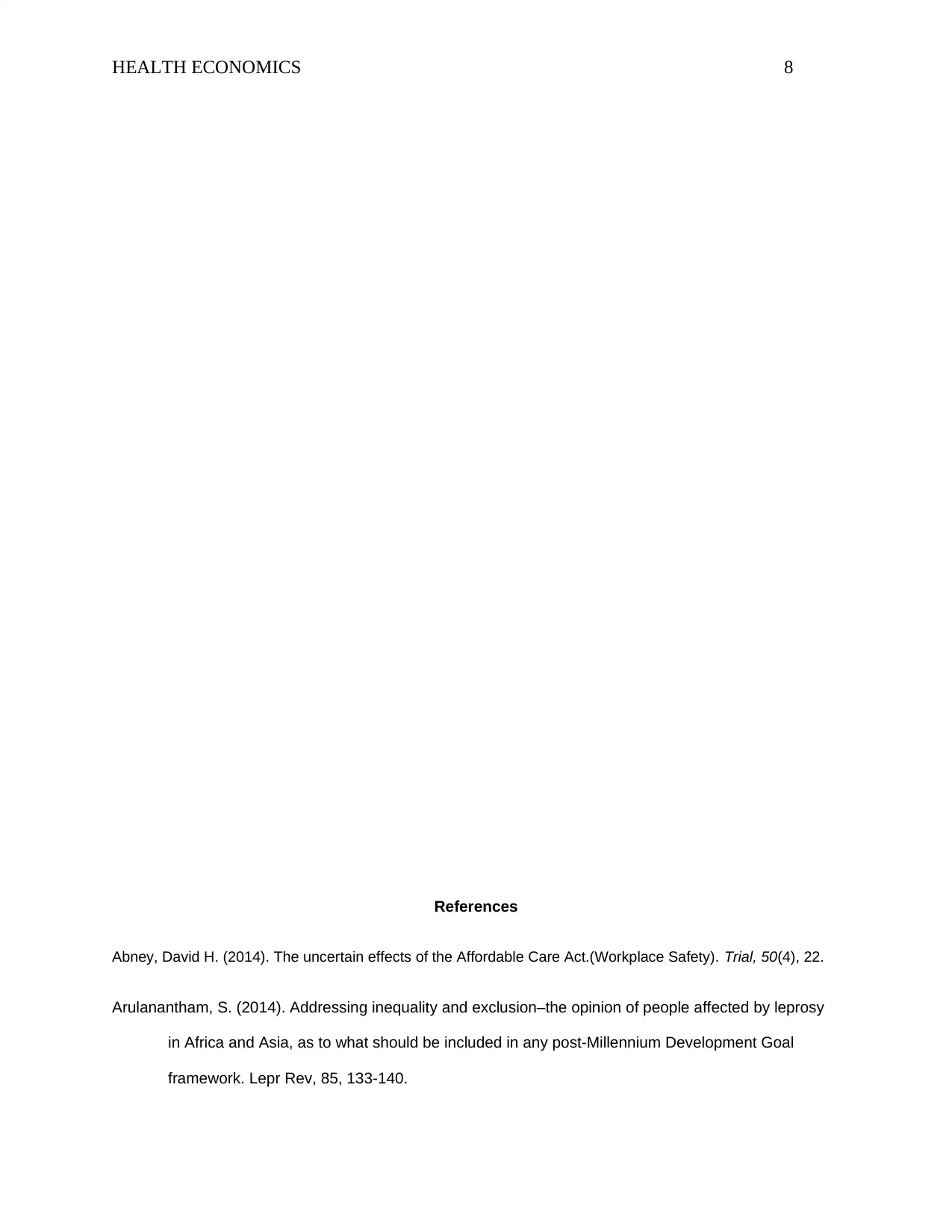
HEALTH ECONOMICS 8
References
Abney, David H. (2014). The uncertain effects of the Affordable Care Act.(Workplace Safety). Trial, 50(4), 22.
Arulanantham, S. (2014). Addressing inequality and exclusion–the opinion of people affected by leprosy
in Africa and Asia, as to what should be included in any post-Millennium Development Goal
framework. Lepr Rev, 85, 133-140.
References
Abney, David H. (2014). The uncertain effects of the Affordable Care Act.(Workplace Safety). Trial, 50(4), 22.
Arulanantham, S. (2014). Addressing inequality and exclusion–the opinion of people affected by leprosy
in Africa and Asia, as to what should be included in any post-Millennium Development Goal
framework. Lepr Rev, 85, 133-140.

HEALTH ECONOMICS 9
Baicker, K., & Robbins, J. A. (2015). Medicare payments and system-level health-care use: the spillover
effects of Medicare managed care. American journal of health economics, 1(4), 399-431.
Frean, M., Gruber, J., & Sommers, B. D. (2017). Premium subsidies, the mandate, and Medicaid
expansion: Coverage effects of the Affordable Care Act. Journal of Health Economics, 53, 72-86.
Graham, D. J., Reichman, M. E., Wernecke, M., Hsueh, Y. H., Izem, R., Southworth, M. R., ... &
Chillarige, Y. (2016). Stroke, bleeding, and mortality risks in elderly Medicare beneficiaries treated
with dabigatran or rivaroxaban for nonvalvular atrial fibrillation. JAMA internal medicine, 176(11),
1662-1671.
Hickner-Cruz, K. (2015). How to Advise Your Physician Clients under the Affordable Care Act. GPSolo,
32, 12.
Hsu, H. E., Kawai, A. T., Wang, R., Jentzsch, M. S., Rhee, C., Horan, K., ... & Lee, G. M. (2018). The
Impact of the Medicaid Healthcare-Associated Condition Program on Mediastinitis Following
Coronary Artery Bypass Graft. Infection Control & Hospital Epidemiology, 39(6), 694-700.
Levy, Helen, Grimes, Donald R., Ayanian, John Z., & Ehrlich, Gabriel M. (2017). Economic effects of Medicaid
expansion in Michigan. The New England Journal of Medicine, 376(5), 407-410.
Mathidza, M. S. (2015). Improving performance management and development systems in the
Department of Health, Limpopo Province (Doctoral dissertation).
Patel, K., & Rushefsky, M. E. (2014). Healthcare politics and policy in America. Public Integrity, 17(1), 94-
96.
Tajeu, G. (2014). Health Maintenance Organization (HMO). The Wiley Blackwell Encyclopedia of Health,
Illness, Behavior, and Society, 1014-1016.
Baicker, K., & Robbins, J. A. (2015). Medicare payments and system-level health-care use: the spillover
effects of Medicare managed care. American journal of health economics, 1(4), 399-431.
Frean, M., Gruber, J., & Sommers, B. D. (2017). Premium subsidies, the mandate, and Medicaid
expansion: Coverage effects of the Affordable Care Act. Journal of Health Economics, 53, 72-86.
Graham, D. J., Reichman, M. E., Wernecke, M., Hsueh, Y. H., Izem, R., Southworth, M. R., ... &
Chillarige, Y. (2016). Stroke, bleeding, and mortality risks in elderly Medicare beneficiaries treated
with dabigatran or rivaroxaban for nonvalvular atrial fibrillation. JAMA internal medicine, 176(11),
1662-1671.
Hickner-Cruz, K. (2015). How to Advise Your Physician Clients under the Affordable Care Act. GPSolo,
32, 12.
Hsu, H. E., Kawai, A. T., Wang, R., Jentzsch, M. S., Rhee, C., Horan, K., ... & Lee, G. M. (2018). The
Impact of the Medicaid Healthcare-Associated Condition Program on Mediastinitis Following
Coronary Artery Bypass Graft. Infection Control & Hospital Epidemiology, 39(6), 694-700.
Levy, Helen, Grimes, Donald R., Ayanian, John Z., & Ehrlich, Gabriel M. (2017). Economic effects of Medicaid
expansion in Michigan. The New England Journal of Medicine, 376(5), 407-410.
Mathidza, M. S. (2015). Improving performance management and development systems in the
Department of Health, Limpopo Province (Doctoral dissertation).
Patel, K., & Rushefsky, M. E. (2014). Healthcare politics and policy in America. Public Integrity, 17(1), 94-
96.
Tajeu, G. (2014). Health Maintenance Organization (HMO). The Wiley Blackwell Encyclopedia of Health,
Illness, Behavior, and Society, 1014-1016.
⊘ This is a preview!⊘
Do you want full access?
Subscribe today to unlock all pages.

Trusted by 1+ million students worldwide
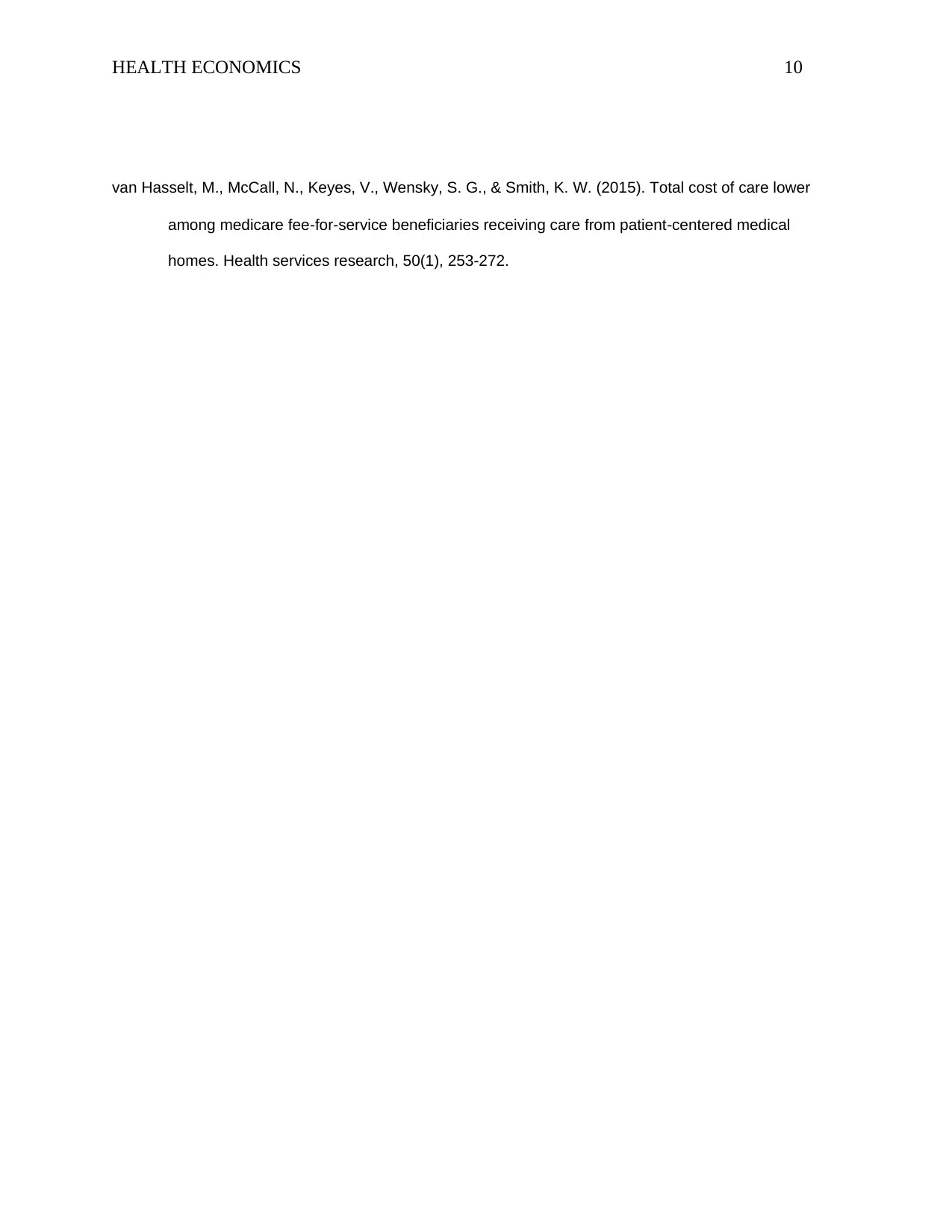
HEALTH ECONOMICS 10
van Hasselt, M., McCall, N., Keyes, V., Wensky, S. G., & Smith, K. W. (2015). Total cost of care lower
among medicare fee‐for‐service beneficiaries receiving care from patient‐centered medical
homes. Health services research, 50(1), 253-272.
van Hasselt, M., McCall, N., Keyes, V., Wensky, S. G., & Smith, K. W. (2015). Total cost of care lower
among medicare fee‐for‐service beneficiaries receiving care from patient‐centered medical
homes. Health services research, 50(1), 253-272.
1 out of 10
Related Documents
Your All-in-One AI-Powered Toolkit for Academic Success.
+13062052269
info@desklib.com
Available 24*7 on WhatsApp / Email
![[object Object]](/_next/static/media/star-bottom.7253800d.svg)
Unlock your academic potential
Copyright © 2020–2025 A2Z Services. All Rights Reserved. Developed and managed by ZUCOL.





